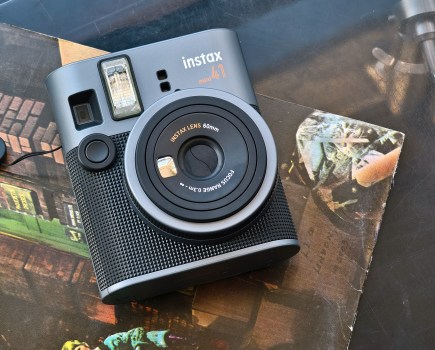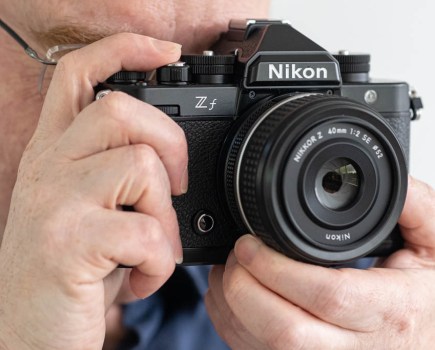As someone who spends a lot of time monitoring the camera market, I think the best cheap full-frame cameras represent the greatest value for money out there right now. Essentially, if you play your cards right and don’t mind shopping second-hand, you can get professional-level image quality for amateur-level prices. It’s all about knowing which full-frame cameras are worth it – and which ones aren’t.
I’ve populated this list with the best full-frame cameras we have reviewed that have seen significant discounts on the second-hand market. Many of these cameras were pretty competitively priced when they were first released, while others were on the expensive side, but all have seen price reductions that make them very tempting. You may not get all the latest features like AI-powered subject-detection autofocus – but you definitely will get a camera capable of taking great pictures.
If you’re not sure what full-frame means, don’t worry – you can scroll to the bottom of this page for an explainer of all the technical terms. The cameras on this list tend to be in the $700 – $1500 price bracket – if you’re looking for even cheaper options, we have guides to the best cameras under $500 / £500, the best cameras under $300 / £300, and even the best cameras under $200 / £200.
The best cheap full-frame cameras – our quick list
- Best cheap full-frame camera overall – Nikon Z5II – buy now
- Best cheap full-frame to buy new: Canon EOS R8 – buy now
- Best cheap full-frame for video: Panasonic Lumix S5 – buy now
- Smallest full-frame camera: Sigma fp – buy now
- Best cheap Nikon DSLR: Nikon D750 – buy now
- Best cheap full-frame Pentax DSLR: Pentax K-1 – buy now
- Best camera for still-life photography: Sony Alpha A7R II – buy now
- Best full-frame Canon DSLR: Canon EOS 6D Mark II – buy now
- Cheapest full-frame Canon: Canon EOS RP – buy now
- Cheapest full-frame mirrorless Nikon: Nikon Z5 – buy now
Looking for the best deal on cheap full-frame cameras? Our ‘Buy now’ buttons are set up to take you to the best prices from trusted retailers. You’ll also find a list of other retailers below each camera, so you can find the right deal for you.
Why you can trust Amateur Photographer
We spend many hours testing every product we recommend, in detail, in a variety of situations and shooting scenarios, and only use experts for our reviews, so you can be sure that you’re getting the best products. Find out more about our expert writers.
The best cheap full-frame cameras: our full list
Best overall
Best cheap full-frame camera overall – Nikon Z5II
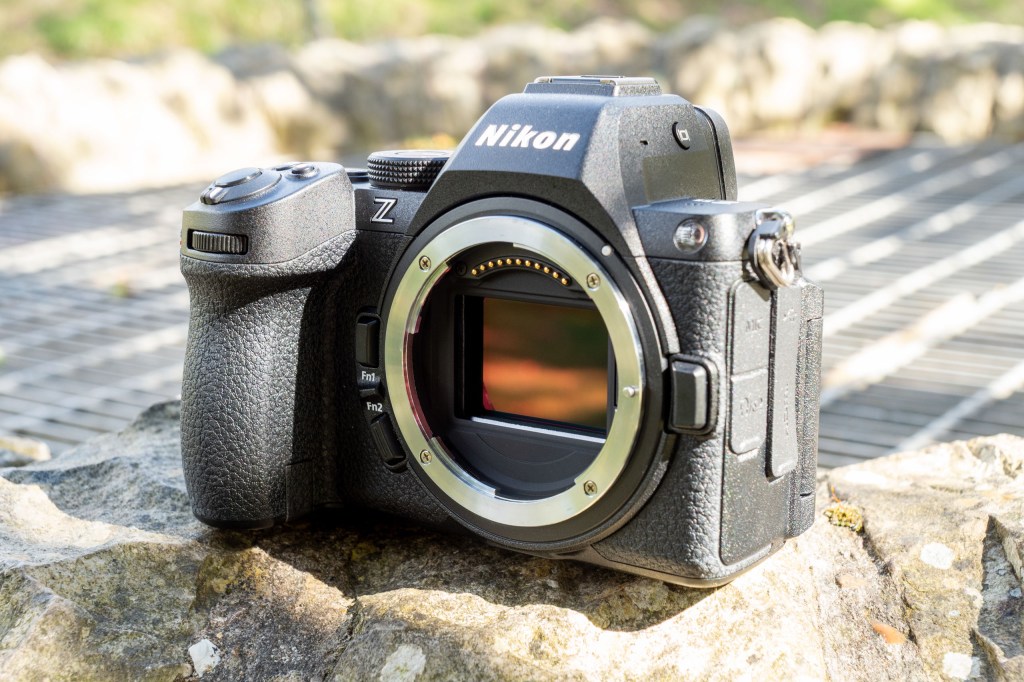
Amateur Photographer verdict
An exciting all-rounder for enthusiasts, the Z5II is packed with features inherited from professional Z series cameras and delivers perfectly focused full-frame shots – even after dark.- Fantastic value Fully articulating touchscreen Proven sensor Multiple subject detection focusing
- Fully articulating touchscreen
- Proven sensor
- Multiple subject detection focusing
- No top-plate LCD for quick viewing of settings
- 4K 60fps video has a crop / no higher resolutions available
- Less portable/travel-friendly than APS-C or MFT rivals
At a glance:
- 24.5MP full-frame BSI-CMOS sensor
- Lens mount: Nikon Z
- ISO 100-64,000
- Weight: 700g with battery and card
- Price: $1700/£1599 body-only
The Nikon Z5 II released in 2025 has a good range of improvements and updates over the previous model, as well as all the main features that made the previous model so popular, including a 24.5MP full-frame sensor, fully articulating touchscreen, a high resolution viewfinder, dual card slots and uncropped 4K 30fps recording. All for less than $1700/£1600.
Aimed at enthusiasts without the budget for higher-priced full-frame models, it inherits a lot of the features of those cameras. There’s also a range of different kit variants available for the Z5 II, including a 24-50mm f/4-6.3 kit lens, a more premium 24-70mm f/4 and an all-rounder option of a 24-200mm f/4-6.3 VR zoom.
The 24MP sensor is capable of producing excellent images. There’s now the faster Expeed 7 processor, which brings with it improvements to operational speeds when compared to the Nikon Z5, especially to autofocus. Cleaner images are now possible at mid-range to high ISOs such as ISO 3200-6400.
Subject detection gives you the option to automatically recognise a greater range of subjects. It offers continuous shooting at a usable 14/15fps when shooting in raw format, or up to 30fps if you’re happy to stick with JPEG only.
In-built image stabilization gives you up to 7.5-stops of shake reduction at the centre of the image, or 6 stops at the edges. Focus point VR is included to give sharper results when the subject is off-centre.
4K 30fps recording is uncropped. You can go up to 60fps but a DX (APS-C) crop will be applied. The fact that the camera has a fully articulating screen and dual SD card slots will be a bonus to vloggers or just those who like their camera to be more versatile.
Read our full Nikon Z5II Review
Best to buy new
Best cheap full-frame camera to buy new: Canon EOS R8
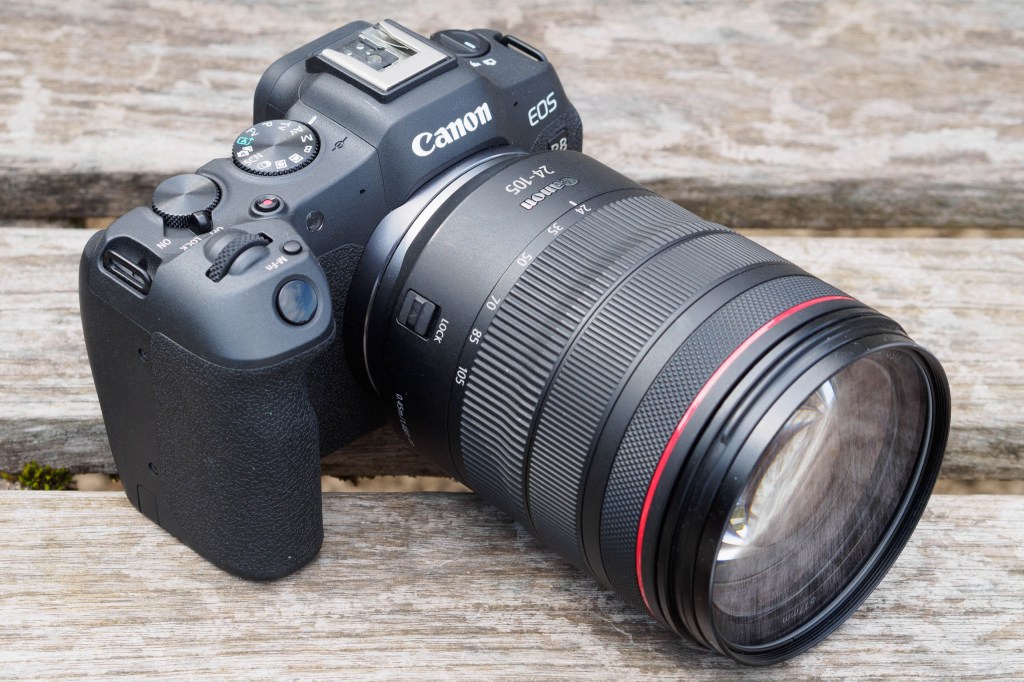
Amateur Photographer verdict
One of the better ‘step-up’ cameras to be released in recent years, the Canon EOS R8 is ideal for those making the jump to full-frame from a smaller system camera.- Excellent quality in JPEG and raw
- Superb autofocus capabilities
- Incredibly lightweight build
- No in-body stabilisation
- Over-simplified design
At a glance:
- 24.2MP full-frame sensor
- Lens mount: Canon RF
- ISO: 100-102,400
- Weight: 461g
- Price: $1,300 / £1,829 body-only
Plenty of manufacturers have marketed ‘entry-level’ full-frame cameras over the years – cameras designed to introduce photographers (and, increasingly, videographers) to the joys of shooting with a larger sensor. The Canon EOS R8 is one of the more recent efforts – a curious combination of high-end internals and an entry-level lightweight body. The end result is a curiosity of a camera, one that’s a little idiosyncratic in use, but ultimately produces undeniably brilliant results.
So, what has Canon done here exactly? Well, the EOS R8 manages to cram a full-frame sensor into a mirrorless body that weighs just 461g, and has even managed to equip it with its cutting-edge autofocus system, thanks to borrowing both a sensor and a processor from the higher-end EOS R6 Mark II. Not only is it lighter than that camera, it’s also significantly cheaper. While it can shoot at up to a decent 6fps with its mechanical shutter, switch to the electronic and you can have up to 40fps, or 30fps in ‘Raw Burst’ mode.
You may be wondering what the catch is. There are several in fact – the EOS R8 lacks many of the EOS R6 Mark II’s features. There’s only one card slot, there’s no weather sealing, and the battery has been downgraded to a 220-shot LP-E17 (so for a day’s shooting, you’ll almost certainly want a spare). More significantly however, the EOS R8 has no built-in image stabilisation, meaning you’ll be completely reliant on lens IS.
This makes it a curious proposition for many photographers – however, as we said up top, you can’t argue with results, and the EOS R8 is capable of producing downright spectacular imagery. Considering you can get it with a lens for less than $2K/£2K, the EOS R8 makes a compelling case for itself as a first full-frame camera.
Read our full Canon EOS R8 review.
Best Panasonic
Best cheap full-frame Panasonic: Panasonic Lumix S5

Amateur Photographer verdict
The Lumix S5 is a solid hybrid and a good alternative to some of the other fine full-frame mirrorless cameras out there under £1000 – though it lacks phase-detection autofocus.- Small, light and well-balanced
- Well-specced for stills and video
- Tough magnesium-alloy body
- Max shutter speed of 1/8000sec
- Only one of two SD slots is UHS-II
At a glance:
- Sensor: 24.2MP CMOS sensor
- Lens mount: Leica L
- ISO: 100-51,200 (extendable to 50-204,800)
- Weight: 714g
- Price: From $1,200 / £609 used, body-only
The Panasonic Lumix S5 has been around for a good five years now. When the Panasonic Lumix S5 II stole headlines at the start of 2023 for its comprehensive suite of video features and sub-2K price, it made for some terrific value among used S5 models for sale. Panasonic was clear that the S5 line is designed to be the full-frame equivalent of the popular, video-oriented GH cameras for Micro Four Thirds.
The Lumix S5 is fairly lightweight for a full-frame model; this was a response to criticisms of the heft of the first cameras in the series, the S1 and S1R. While it has plenty to entice the vlogger and video shooter, it’s decent when it comes to stills, too.
The Lumix S5 produces sharp, vivid images full of vibrant colour, and boasts a rack of useful features, including an electronic shutter for silent shooting. This can manage shutter speeds of up to 1/8000sec – decent, but rivals are faster. It can also use the sophisticated stabilisation system to stitch together eight separate exposures with adjustments to the sensor position, resulting in a 96MP image.
This was Panasonic’s most affordable full-frame camera on release, and the second-hand market has been very kind to it, with models in very good and excellent condition plentifully found for less than £1K. The Leica L lens mount gives you access to an impressive range of lenses, and helps cement the Lumix S5 as a very tempting and reasonably priced proposition.
Read our full Panasonic Lumix S5 review
Smallest camera
Smallest full-frame camera: Sigma fp

Amateur Photographer verdict
Delivering full-frame image quality and interchangeable lenses in the smallest possible package, the Sigma fp is definitely an oddity. It’s fiddly to use, but we rather admire it.- Incredibly portable for full-frame
- Modular design can be customised
- Back-illuminated sensor delivers great performance
- No viewfinder
- Not the most comfortable to hold and use
- Slow focus system
At a glance:
- Sensor: 24MP CMOS sensor
- Lens mount: Leica L
- ISO: 100-25,600 (extendable to 6-102,400)
- Weight: 422g
- Price: $1,899 used / £1,179 used, body only
As you can see throughout this page, the form factors of full-frame cameras tend to look quite similar. As such, it’s nice to see a manufacturer taking a bit of a risk and coming out with something that looks genuinely different – so it is with the Sigma fp, a tiny cuboid that scarcely seems like it’s big enough to hold a full-frame sensor, but most assuredly is.
As Sigma CEO Kazuto Yamaki tells it, the design concept for the Sigma fp was to make the smallest possible full-frame camera, thereby delivering a format suitable for travel photography. Naturally, this means a few sacrifices are made; there is no viewfinder, no mechanical shutter, no real handgrip, and no built-in flash. However, that’s not to say you have to completely do without, as many of these things are available as optional add-ons. The Sigma fp is designed to be modular, which is a super-interesting concept for a full-frame camera.
But, does it work? In our review, we were broadly positive, if a little circumspect about certain things. Fundamentally, if you want a small full-frame camera, the Sigma fp is it, and it produces great-looking images, with RAW files every bit as good as those from larger cameras. You do need to pair it with small L-mount primes for the concept to still make any sense, though.
Sigma subsequently released the Sigma fp L, more of a companion piece than a successor, with a high-resolution 61MP sensor, and the addition of an optional viewfinder to bolt onto the side. If a viewfinder is a deal-breaker for you, this is the buy, but the original Sigma fp can generally be picked up cheaper if not.
For more compact options have a look at our guide to the best smallest mirrorless cameras!
Best Nikon DSLR
Best cheap Nikon DSLR: Nikon D750
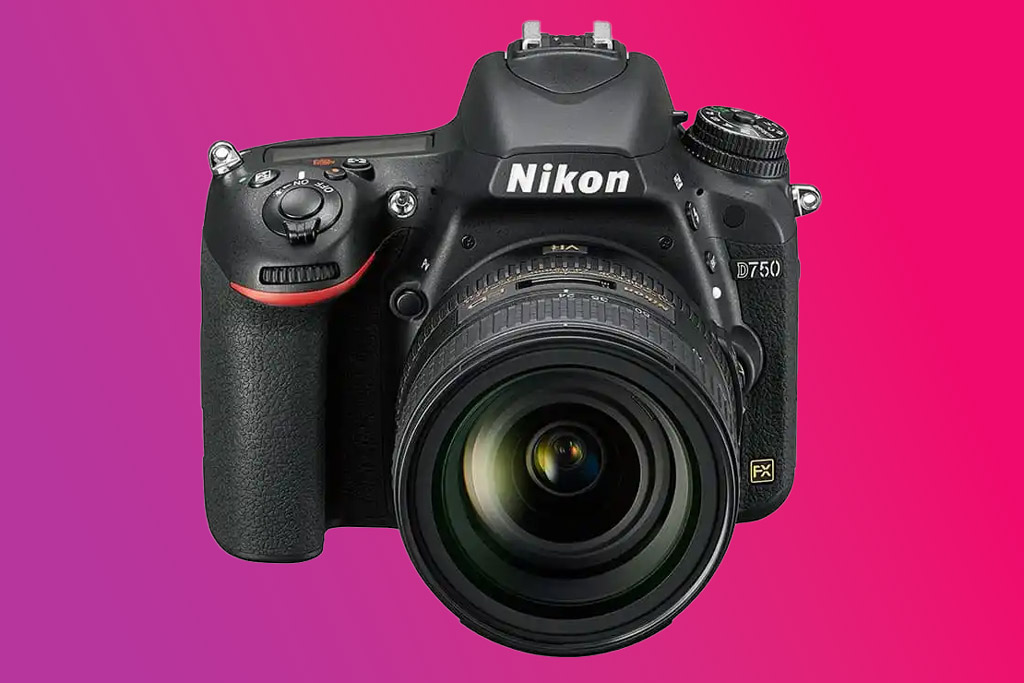
Amateur Photographer verdict
Quick and accurate autofocus and good build quality make for a DSLR that has become a classic for a reason. The Nikon D750 offers terrific value for money, particularly on the second-hand market.- Great lens selection
- Well-engineered handling
- Fast, reliable autofocus
- Shutter speed tops out at 1/4,000sec
- No AF-On button
At a glance:
- Sensor: 24.3MP FX CMOS sensor
- Lens mount: Nikon F-mount
- ISO: 100-12,800 (extendable to 50-51,200)
- Weight: 980g
- Price: $650 body only / £487 body only
Nikon’s D750 has been a popular choice of DSLR for enthusiast semi-pro and pro photographers. It was overshadowed in early 2020 by the arrival of the Nikon D780, but given that it’s now available for £750 body-only, the D750 is still a very attractive proposition. Inside the D750 is 24.3MP full-frame CMOS sensor with an optical low-pass filter to cut out moire patterning. This chip is paired with an Expeed 4 processing engine, which enables a continuous shooting rate of 6.5fps at full resolution.
Although the D750 pre-dates Nikon’s SnapBridge technology, it has Wi-Fi connectivity to enable image-sharing and remote control via a smartphone running Nikon’s Wireless Mobile Utility app. Nikon uses a monocoque design for the D750 and it is made from a mix of thermoplastic and carbon fibre with magnesium alloy top and bottom sections. It all adds up to a rugged and solid-feeling camera.
There are 51 user-selectable AF points, and the D750 gets subjects sharp very quickly, even in very gloomy conditions when you’re composing in the viewfinder. As you’d expect, the image quality from the Nikon D750 is excellent up to around ISO 1600, and there’s good dynamic range, but the Highlight Metering Mode is especially useful when it’s essential to avoid blown-out highlights.
Using the long-established Nikon F-mount, there are a wide range of lenses available, starting with affordable 50mm lenses, like the ‘nifty fifty’ Nikon 50mm f/1.8G lens, going all the way up to 800mm telephoto lenses.
Nikon has covered almost every feature likely to appear on the wish-list of an enthusiast photographer and added a few extra for good measure. The build quality of the camera is very good and it strikes a great balance between the size and weight. Thanks to the large grip at the front the D750 feels incredible in hand, particularly with larger lenses. With the mode dial, button lay-out and menu system being akin to Nikon’s entry-level DSLRs, any amateur photographer upgrading to full-frame should feel right at home. In the D750 Nikon created a camera that got all the fundamentals right and, as a result, it remains a great all-round DSLR.
Best Pentax DSLR
Best cheap full-frame Pentax DSLR: Pentax K-1

Amateur Photographer verdict
A camera designed for a wide audience, capable of excellent dynamic range and high resolution. Pentaxians have championed the original K-1 for years, and at second-hand prices, it’s worth considering.- Shake Reduction image stabilisation
- Hardy, weather-sealed body
- Great image quality with excellent dynamic range
- Dated autofocus system
- Not much cop for video
At a glance:
- Sensor: 36.4-million-pixel full-frame CMOS
- Lens mount: Pentax K-mount
- ISO: 100-204,800
- Weight: 1,010g
- Price: from $1,000 body-only / around £850 body-only
For those decided on a DSLR rather than a mirrorless camera, it’s worth considering DSLR-specialists Pentax. The venerable camera manufacturer has repeatedly reaffirmed its commitment to the DSLR format at a time when other manufacturers are uniformly jumping (or, to be honest, have long since jumped) to mirrorless. The Pentax K-1 was the first full-frame mirrorless DSLR the firm released, and the fact that it has since been superceded by the K-1 Mark II makes it available second-hand for a great price.
The 36.4MP full-frame sensor produces top-quality images, as we discovered in our full testing of the K-1. Detail and dynamic range are consistently excellent, and this performance is well-maintained as you move up through the sensitivities – it’s only past ISO 800 that dynamic range starts to really drop, and even then, it’s still very good. The Shake Reduction image stabilisation is also very good, delivering up to five stops of effective compensation.
The hardy, weather-sealed body feels safe to use outdoors, with a well-sculpted grip that provides a secure hold. The metering system does have a tendency towards underexposure, as was a characteristic of previous Pentax DSLRs, but it’s nothing that a quick shift of the Exposure Compensation dial can’t fix.
We’ve long been fans of the Pentax K-1, rating it as one of our standout second-hand cameras after we published our full review. Some caveats to bear in mind, though – its autofocus system does feel pretty dated, especially now in the days of phase-detection pixels and AI-powered subject-recognition. Also, while the K-1 does shoot Full HD video, it’s a photographer’s camera first and foremost – video shooters can get better value for money elsewhere.
Read our full Pentax K-1 review
Best for still-life
Best camera for still-life photography: Sony A7R II

Amateur Photographer verdict
A small but immensely powerful camera, with speedy focusing and 5-axis IBIS. Sony’s A7R II is part of its high-resolution line of mirrorless cameras, and offers dynamic range that still impresses.- Excellent resolution and noise performance
- Effective 5-axis stabilisation
- Tremendous dynamic range
- Poor battery life
- File sizes will eat through data
At a glance:
- Sensor: 42.4-million-pixel, full-frame Exmor R CMOS sensor
- Lens mount: Sony E-mount
- ISO: 100-25,600 (50-102400 extended)
- Weight: 625g
- Price: $1,200 – $1,800 body only / from £664 body only
With 42.4million effective pixels on its backside illuminated sensor, the mirrorless A7R II is the highest-resolution camera in our chosen line-up of budget full-frame cameras. Despite that high pixel count, the A7R II’s Bionz X processing engine still enables full-resolution shooting at up to 5fps. The price of this powerful camera has been driven down by its two successors, the A7R III and A7R IV, so can be picked up for a bargain price – in the UK at least, for now.
- With a high resolution sensor and excellent value for money, this would be an great choice as one of the best cameras for still life photography.
There’s also a hybrid autofocus system with 399 user-selectable AF points that cover 45% of the imaging area, which means that you can target the subject precisely. It’s also pretty fast, but the A7R II is more likely to appeal to landscape photographers than avid sport-shooters.
Our tests revealed that the A7R II has excellent dynamic range, hitting 13.1Ev at ISO 100, which, paired with its superb detail resolution, great noise control and effective 5-axis image stabilisation system, explains its enduring attractiveness to landscape photographers.
The Sony A7R II is also capable of recording 4K video. What’s more, in Super 35mm mode, there’s no pixel binning and features such as S-Log2 Gammas and Time Code are on hand along with 3.5mm ports to connect an external mic and headphones.
The camera benefits from 5-axis In Body Image Stabilisation (IBIS), and this works with any lens attached to the camera – great for using budget lenses without optical image stabilisation, or even old manual lenses used with an adapter. The A7R II delivers great accuracy and speed of focusing, particularly in low light, thanks to the the fast-hybrid AF system. The performance of the 42.4MP sensor is sensational and the way it controls noise and handles detail right up to ISO 25,600 is a real eye-opener.
Read our Sony Alpha 7R II review
Best Canon DSLR
Best full-frame Canon DSLR: Canon EOS 6D Mark II
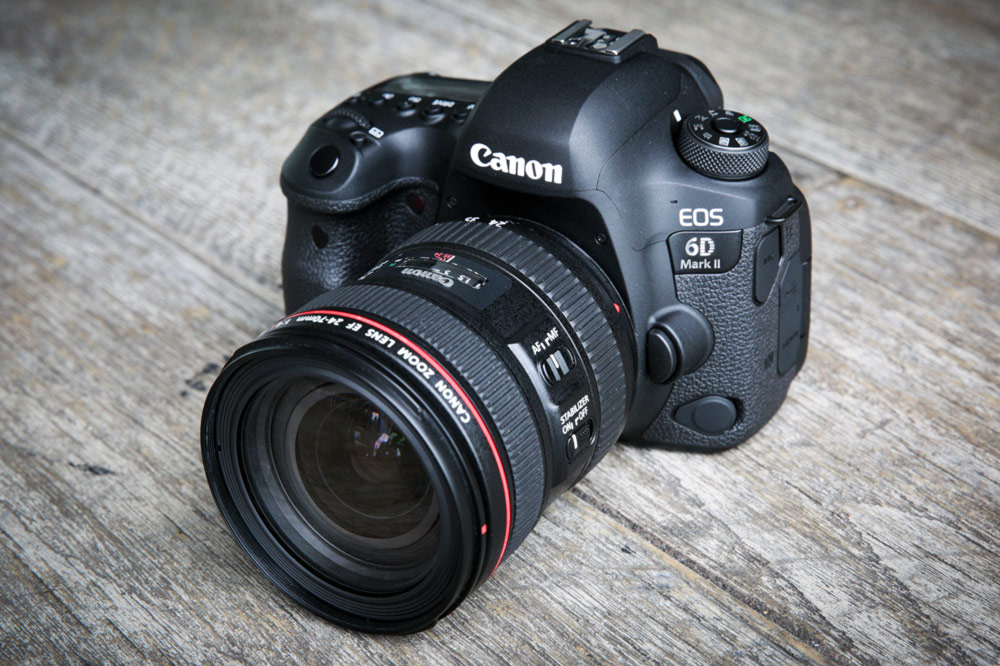
Amateur Photographer verdict
This DSLR was a notable improvement on the original EOS 6D. While it does lack a few features, its price makes this easy to forgive, and the EF lens selection is brilliantly expansive.- Responsive autofocus
- Loads of EF lenses
- Handy vari-angle screen
- AF points quite centrally clustered
- Not 4K
At a glance:
- Sensor: 26.2MP full-frame CMOS sensor
- Lens mount: Canon EF
- ISO sensitivity: ISO 100-40,000
- Weight: 765g
- Price: from $1,199 (body only) / £1,289 (body only)
Although it’s a DSLR, the 26.2MP 6D Mark II has a Dual Pixel CMOS AF design sensor, which means that it uses phase detection autofocusing in Live View mode as well as when the viewfinder is used to compose images. Consequently it focuses quickly and accurately, however you decide to compose your shots. It’s worth bearing in mind, though, that the 63 AF points available in the viewfinder are grouped quite close around the centre of the frame.
The snappy focusing in Live View mode is especially useful on the 6D Mark II because it has a vari-angle screen that can be angled for viewing from any angle; whether shooting landscape or portrait format images. Canon has also done a great job of implementing touch control so you adjust settings and set the active AF point by tapping on the screen.
That screen is also of use when you’re shooting video, which tops out at Full HD (1920×1080) at 59.94fps. Further good news is that the 6D II maintains its good detail resolution up to around ISO 6,400, making it a versatile all-rounder.
As the Canon EOS 6D Mark II uses the Canon EF lens mount, there are a wide range of Canon EF lenses available, as well as a wide range of lenses from other manufacturers, giving you a great choice of both new and used lenses to look at.
The EOS 6D Mark II is a stepping stone for existing Canon users to get into full-frame photography and is a viable alternative to the more advanced EOS 5D Mark IV. Those thinking about a move away from a Canon APS-C format DSLR will need to factor in the extra expense of upgrading a few EF-S lenses to a new collection of EF lenses. But when size and weight are critical – for example, when travelling or on location – the EOS 6D Mark II really comes into its own.
Read our Canon EOS 6D Mark II review
Cheapest Canon
Cheapest full-frame Canon mirrorless: Canon EOS RP
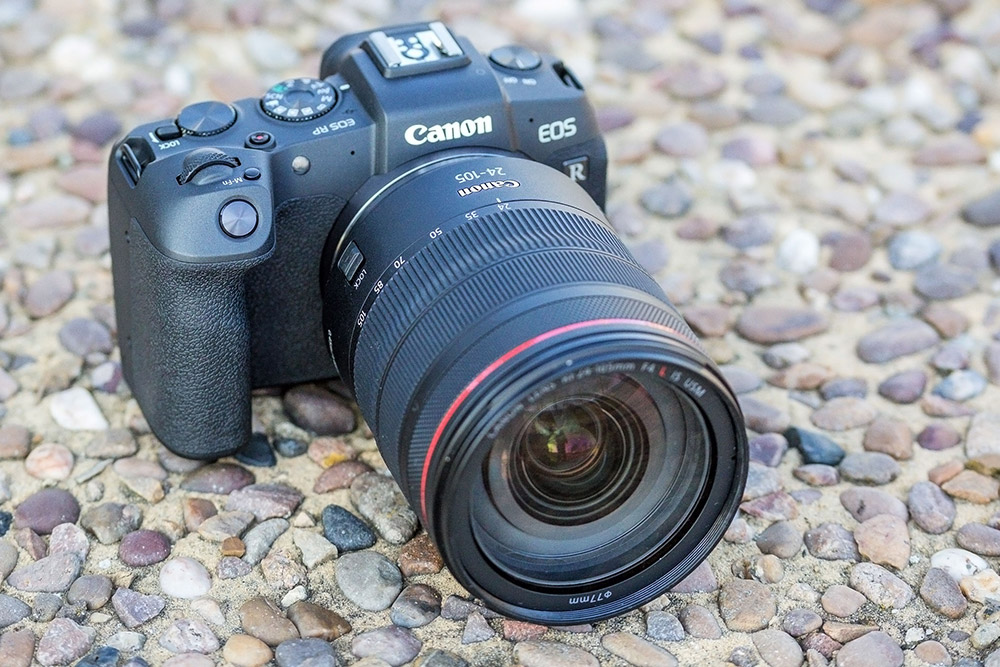
Amateur Photographer verdict
While the EOS R8 has stolen some of its thunder, the EOS RP still offers full-frame image quality in a small, lightweight package that’s generally very pleasant to shoot with.- Very good high-ISO performance
- Comprehensive autofocus system
- EF-lens compatibility
- No in-body stabilisation
- Viewfinder hard to see in poor light
- No AF joystick
At a glance:
- Sensor: 26.2MP full-frame dual-pixel CMOS
- Lens mount: Canon RF
- Sensitivity: ISO 100-40,00 (extendable to ISO 50-102,400)
- Weight: 485g (with battery and card)
- Price: $800 (body only) / £950 (body only)
The Canon EOS RP was the second full-frame mirrorless camera in Canon’s line-up, and is compact and affordable. Like the Canon EOS 6D Mark II DSLR, the EOS RP has a Dual Pixel CMOS AF design sensor; yet it has a remarkable 4779 selectable AF points. Also, as the RP is a mirrorless camera, those points ara accessible for use whether the image is composed in the electronic viewfinder or on the 3-inch 1.04-million-dot, vari-angle touchscreen.
In a step-up from the 6D Mark II, the RP is capable of shooting 4K UHD (3840×2160) video at up to 25fps. And, of course, you get to use the excellent AF system for shooting video as well as stills. While Canon has since introduced two EOS R cameras that are designed for entry-level and budget users – the EOS R7 and EOS R10 – both of these are APS-C models, not full-frame.
Existing Canon DSLR photographers who are looking to switch to a mirrorless camera will appreciate the familiar handling of the RP and can use the existing EF-mount lenses via an adapter. Indeed, we found the EOS RP worked seamlessly with EF-mount lenses, so EOS DSLR users would only need to acquire an RP body to start shooting straight away.
They won’t be disappointed by the images which have excellent levels of detail up to around ISO 12,800. There is a range of RF-mount lenses, but as with any relatively new camera system, it would be wise to have a look at what lenses are available, and how much they cost before investing in a new system.
With the EOS RP Canon revealed its initial vision for what an entry-level, full-frame mirrorless model should look. It got a lot right, with a body design that handles much better than its odd-looking profile might suggest. Rather than simply porting across the existing EOS DSLR interface, it employed some clever new ideas, such as the Dial Function setting and Fv exposure mode. There’s plenty to like about this camera!
Cheapest Nikon
Cheapest full-frame mirrorless Nikon: Nikon Z5
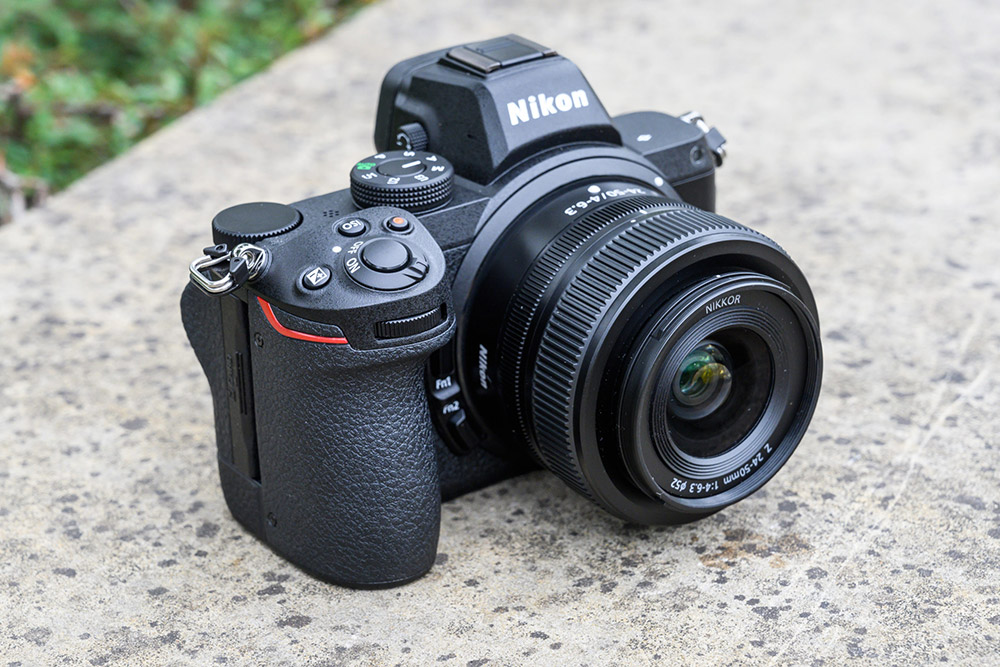
Amateur Photographer verdict
A reliable full-frame camera that has a quality feel, solid set of specifications and a price point that adds further to its appeal. We wouldn’t mind an updated version though, Nikon!- Dual card slots
- Excellent build quality
- F-mount lens compatible (with adapter)
- Vicious 1.7x crop on 4K
- Only 4.5fps burst
At a glance:
- Sensor: 24.3MP CMOS sensor
- Lens mount: Nikon Z mount
- ISO: 160-51200 (50-102400 extended)
- Weight: 675g (with battery and card)
- Price: from $800 body only / £950 body only
Announced in July 2020, the Nikon Z5 was introduced as the ‘catalyst’ camera, intended to push DSLR or APS-C format photographers to invest in a full-frame mirrorless model.
It’s also Nikon’s most affordable full-frame mirrorless camera, which means there are a few compromises in comparison with the 24.5MP Z6 II that sits above it in Nikon’s mirrorless camera range, but it still has plenty to appeal to experienced photographers.
For example, while the Z5’s 24.3MP sensor has standard design and isn’t backside illuminated, it has a 273-point hybrid AF system with Eye-detection for humans and animals in stills mode. There’s also the same 0.39-inch 3,690,000-dot OLED electronic viewfinder as Nikon’s other full-framers, a responsive 3.2-inch 1,040,000-dot tilting touchscreen and dual SD card ports plus 4K video capability.
With detail maintained well up to around ISO 12,800 and good dynamic range, the Z5 is a strong contender. The Nikon Z series has also a growing range of Z-mount lenses. However, as they’re all new and mostly premium optics, you may want to have a look through your options. They can be quite pricey.
Originally touted as an ‘entry-level’ model the Z5 is much more advanced than this basic classification suggests. It’s alike to the original Z6 in terms of its build quality and handling but, by making a few spec alterations, Nikon was able to make it cheaper. The Z5 is sometimes available as part of a bundle with a 24-50mm kit lens – something that might appeal to photographers who feel like they’re ready to advance to full-frame.
We’ve since seen the arrival of the Nikon Z5 II, a long-awaited update to this camera that adds improved subject-detection autofocus and improved high-ISO performance thanks to the backside-illuminated sensor. This has meant that prices on the original Z5 have continued to come down, especially on the used market, and these days we’re seeing good-condition models at the $730 / £730 mark, rather than $850 / £900 as we were seeing previously.
What to look for in the best cheap full-frame cameras
In brief, here are the key specs and features you should be mindful of when shopping around for the best cheap full-frame cameras.
DSLR or mirrorless? You’re going to be choosing one or the other in the question of DSLR vs mirrorless. Mirrorless cameras tend to be smaller, with more sophisticated autofocus and video systems. DSLRs are generally more rugged and weatherproof, with better battery life, and the immediacy of an optical viewfinder (mirrorless systems use electronic ones).
The best DSLR systems also tend to have more lens options, simply because they’ve been around longer. However, the best mirrorless cameras very much represent the future of imaging, with manufacturers like Canon and Nikon betting big on their mirrorless line-ups, so these can be the more forward-thinking buy.
Lens mount. Look at the lenses available for a system, particularly with regard to what you want to shoot. A full-frame sensor is only as good as the lens attached to it.
Continuous shooting speed. If you’re capturing fast action, then a camera’s burst speed could mean the difference between nailing and missing the shot. While the older cameras on this list won’t be matching the blistering burst speeds of the likes of the Nikon Z9, you can still get respectable frames per second (fps) rates on a cheap full-frame camera.
ISO range. The higher an ISO ceiling a camera can reach, the better its performance in low light, generally speaking. However, some cameras do better at high ISOs than others, so it’s always worth doing some research rather than just relying on numbers.
What is a full-frame camera?
‘Full-frame’ is description of the size of a camera’s imaging sensor. In a full-frame camera, the sensor measures 36x24mm, which is roughly the size of a single frame of 35mm film – hence the name. A full-frame sensor is physically larger than many you’ll find in other cameras (APS-C, Four Thirds, 1-inch, etc) and larger sensors confer all sorts of advantages, such as greater dynamic range. Those who want to know more about sensor sizes can check out our extensive piece on APS-C vs Full-Frame.
Is it worth getting a full-frame camera?
If you care about great image quality then yes, it is definitely worth at least considering getting a full-frame camera. The physically larger sensor size of full-frame allows for the creation of images with superior dynamic range compared to smaller-sensor cameras. Full-frame cameras will perform better in low light, and are also better for cleanly separating subject and background to produce images with an aesthetically shallow depth of field. While they can be expensive, as we’ve seen in this guide, full-frame cameras can also be picked up for tempting prices if you don’t feel you have to have the newest model.
What are the disadvantages of full-frame cameras?
Setting aside the cost, one of the main disadvantages of full-frame cameras is the fact that they are physically bigger and heavier than their crop-sensor counterparts. This can make them difficult to use for extended periods, especially when shooting on location. Also, something worth noting is that the cost and weight disadvantages of full-frame cameras also apply equally to full-frame lenses – they, too, are big, heavy and expensive.
How we test cameras
We test cameras primarily by using them to take photographs and video in a wide range of real-world situations, including shooting in low-light, as well as bright conditions with harsh lighting to test dynamic range. We evaluate their control layouts and handling, and the usability of their viewfinders and screens. We assess their autofocus across a range of different subjects and shooting scenarios and check their continuous shooting capabilities. For example, to see how versatile the Canon EOS R8 is, we tested this with both RF-mount lenses, as well as older DSLR lenses with Canon’s EF to RF adapter.
We also examine the effectiveness of their image stabilisation systems. Last but by no means least, we critically evaluate the image quality, in both JPEG and raw, to assess colour reproduction, white balance performance, resolution, high-ISO noise, dynamic range, and more. We then take all these factors into account, along with such things as portability and lens systems, when giving our final conclusion and score. You’ll find the full breakdown of how each camera has performed in our full reviews.
Recent updates
- October 2025: Prices updated, Nikon Z5II added as best cheap full-frame camera overall, Nikon D4 no longer available to buy and removed from list. How we test cameras section expanded to add clarity and additional information.
Further reading:
- What are the best mirrorless cameras you can buy?
- The best second-hand full-frame camera bargains
- The 12 Best Nikon DSLR Cameras Ever






